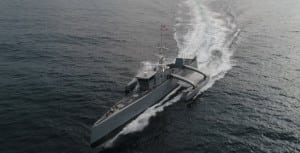The Chief of Naval Operations (CNO) this week said the unmanned vessels planned in the Navy’s new future fleet plan will help fill in gaps in intelligence, surveillance, reconnaissance and targeting (ISR&T) in a larger more distributed fleet.
“With a more distributed force, we’re going to potentially come at the adversary across a bunch of different vectors and we’re assuming the adversary is going to continue to grow in numbers. We’re going to need to be able to target that force or target those nodes whether they’re ashore or whether they’re at sea. And that targeting capability isn’t always going to come from national technical means, so it’s not always going to come from space,” CNO Adm. Make Gilday said Tuesday during a virtual Defense One event.

During the event, Gilday discussed the state of the Navy in the context of the new Battle Force 2045 fleet plan Secretary of Defense Mark Esper unveiled, in basic terms, last week (Defense Daily, Oct. 6).
Gilday said the Navy will require a high degree of organic ISR required to find, fix, and destroy targets with the shooters in the fleet.
“And so it’s a gap that is going to continue to widen unless, I think, we move heavier in the direction of unmanned and rely more on unmanned for many of those functions.”
He said in scenarios against China in the next few decades, the Navy will have to operate from further back from the adversary with both using long range stand-off weapons to target the other.
“So you got to get in there to target them, and I just don’t see an answer right now, aside from heavier investments in unmanned, to take us to a place where we can scale that capability and close that gap that we think is going to be required in the future,” Gilday continued.
Relatedly, Gilday said the new plan projecting out to 2045 looks into new platforms as part of a hybrid fleet. He said this is a fleet “that we need to build that brings together not just the fleet that we have today but it also takes a deep look at unmanned and what’s promising about unmanned in terms of numbers, in terms of distributed fire, in terms of C2 [Command and Control] nodes [and] electronic warfare that we can get out there and field in an affordable way.”
He said it is important that while the Navy pursues new unmanned and autonomous vessel technology, they understand and address technical risks.
“So we are also very aware of the need to prototype and the need to take this in a deliberate but urgent manner in order to get a point where we can actually scale it.”
Navy officials often talk about understanding the need to prototype deliberately since Congress appears less enthusiastic on rapidly building unmanned vessels.
The Senate Armed Services’ fiscal year 2021 defense authorization bill would require the service to qualify main engines and generators for unmanned surface vessels (USVs) before moving to procurement while the Undersecretary of Defense for Research and Engineering would also have to review USVs and Unmanned Undersea Vehicles (UUVs) before they receive full vessel research and development funding (Defense Daily, June 11).

Committee aides told reporters the provision is intended to require technological maturity and draw a distinction between subsystems and full-scale prototyping.
The House Armed Services Committee’s own version of the bill would prohibit the Navy from procuring any Large USVs until a technology maturation certification is submitted to Congress. This would guarantee the hull, mechanical and electric systems of the LUSV have at least attained technology readiness level seven and can be autonomously controlled for at least 30 days (Defense Daily, June 23).
The committee mark also recommended cutting funds for two LUSV prototypes until the Navy can prove enough design maturity and it understands autonomy issues. Committee staffers told reporters they are wary of moving to serial production too quickly if it includes capabilities the Navy does not completely understand.
Gilday admitted the larger USVs may eventually feature surface to air missiles.
“It might and so I think you need to be open minded about what the payloads on those platforms could be, but obviously they have an adjunct magazine potential capability – to bring more lethal firepower to the fight in a distributed kind of way.”
However, the CNO said in the new fleet plan the unmanned vessels can plan several roles.
“So deeper magazines in terms of volume and capability. I think there’s also C2 and [Electronic Warfare] function to some of those unmanned vessels can play. It could be vital to us as well, in a distributed fight.”